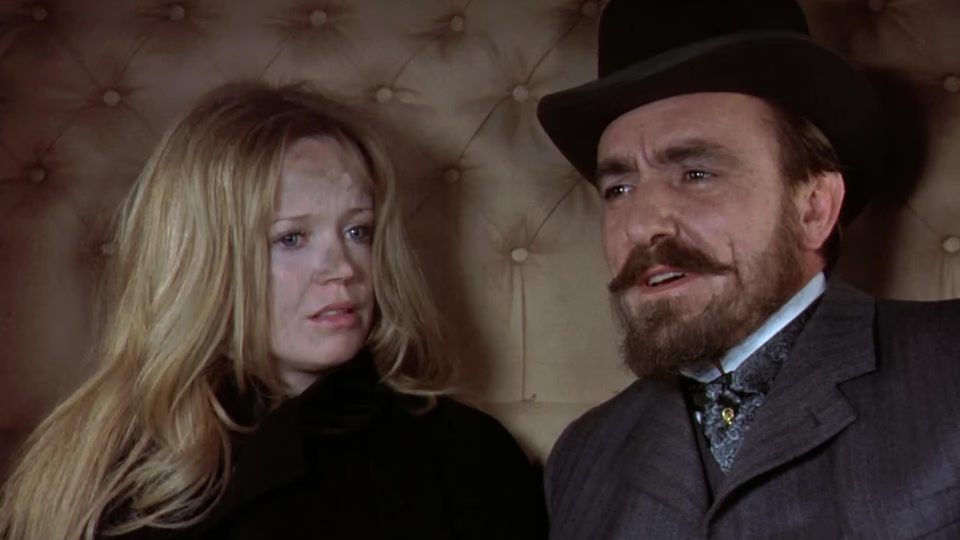Hands of the Ripper

Peter Sasdy’s The Hands of the Ripper arrives as a curious hybrid of Hammer Horror and Freudian case study, one that can’t decide whether it wants to be a supernatural thriller or a critique of Victorian-era psychoanalysis. The result is a film that shows flashes of genuine craftsmanship while ultimately succumbing to the limitations of both its budget and its confused narrative ambitions.
The plot sees Eric Porter as Dr. Pritchard, a rational-minded psychoanalyst who takes on the case of Anna, played by Angharad Rees, a young woman plagued by murderous blackouts she cannot remember. What Pritchard doesn’t realize—though the audience quickly does—is that Anna is possessed by the spirit of her father, Jack the Ripper.
To Sasdy’s credit, he demonstrates considerable ingenuity in stretching his modest budget. His approach to period atmosphere is resourceful—tight framing on a train platform creates the illusion of a bustling Victorian station while actually showing us only a few feet of set decoration. Street scenes employ similar sleight of hand, using strategic camera placement to suggest whole thoroughfares while showing us little more than a single carriage and a handful of extras. The dimly lit interiors, while born of economic necessity, lend the film an appropriately dingy, claustrophobic atmosphere that serves the material well.
Where Sasdy doesn’t economize is the violence. The opening stabbing establishes the film’s unflinching approach to bloodshed, but it’s a later sequence—a fistful of hatpins thrust into a victim’s eye—that provides the movie’s most memorable jolt when Sasdy’s camera zooms in as the wounded woman pulls her hands away to reveal the protruding pin.
The film’s finest sequence involves a character impaled on a saber who, in desperation, uses a door handle to extract the blade. It’s both inventive and visceral—the kind of creative problem-solving that elevates B-movie material, even if the medical realism is questionable.
Unfortunately, the screenplay fails to match the director’s resourcefulness. Porter’s Dr. Pritchard embodies the worst aspects of a Holmes-like investigator—cold, pedantic, and insufferably arrogant—without the compensating brilliance that might engage our interest. His stubborn adherence to Freudian explanations despite mounting evidence of supernatural forces renders him more irritating than sympathetic. The film thus becomes an unintentional critique of psychoanalysis, suggesting that empirical science is blind to spiritual realities.
The plot also stumbles repeatedly over contrivances and holes. Anna’s implausible tardiness to dinner, a murdered royal advisor generating no investigation, and other narrative shortcuts betray lazy screenwriting.
Most egregious is the literal interpretation of the title, where Anna’s hands physically transform during her possession states. These grotesque appendages, scarred by syphilis, shift the film from psychological thriller into unintentional comedy. Contemporary viewers familiar with the “man-hands” episode of Seinfeld may struggle to avoid guffawing.
By the time the finale arrives, Sasdy’s reach finally exceeds his grasp. Set on a soundstage masquerading as St. Paul’s Cathedral, the sequence relies on obvious matte paintings and still photographs that strain credibility. When a character grips a railing that exists only in the painted background, the already brittle becomes laughable. The climactic fall, achieved with what is clearly a doll on a string, undermines what should have been the film’s most dramatic moment.
Still, The Hands of the Ripper succeeds as a case study in resourceful filmmaking. Sasdy proves that creative camera work and atmospheric lighting can compensate for financial limitations—to a point. Like its central character, the film suffers bouts of possession by something it cannot fully control: the ghost of the better movie it might have been with more money and a stronger script.
The result is a film that’s more interesting to analyze than to experience, one that demonstrates both the possibilities and pitfalls of ambitious filmmaking on a meager budget.